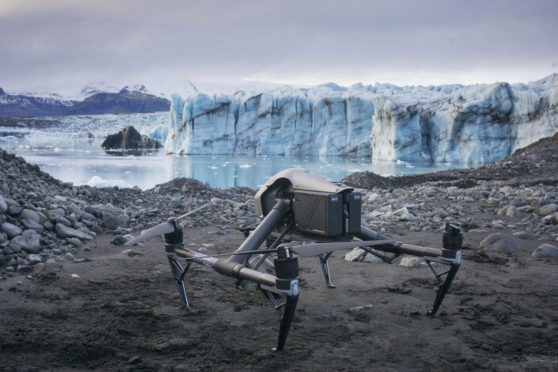New technology developed at Dundee University has revealed the extent of melting from some of Iceland’s largest glaciers.
A new 3D process which involves drone photography and aerial pictures from the 1980s has been developed by Dr Kieran Baxter.
The technique has allowed Mr Baxter to document the amount of ice loss on a group of outlet glaciers on the south side of Vatnajökull, one of the largest ice caps in Europe.
Aerial mapping photographs taken by the National Land Survey of Iceland were modelled in 3D using photogrammetry software.
While this process is routinely used by scientists to measure the historical ice surface, Mr Baxter used the models to align with current drone footage to highlight the impact of climate change on the region.
He said: “We have been working to produce images that are both engaging and easy to understand. It is important to show how climate change is physically and visibly affecting the region.
“To do this, we developed a novel process based on principles that are used by glaciologists to measure ice-volume loss.
“This method allows us to compose unique aerial views of past landscapes and to see how they have changed over the last 30 to 40 years.
“This period, which is within living memory for many people, has seen accelerated melt in southeast Iceland.
“While we have a fantastic resource of mapping photographs from the 1980s, this method can also be applied to aerial photographs that are even older.
“The archives are huge and we have barely scratched the surface in terms of using them to better show how the warming climate is revealed in our landscapes.”
Vatnajökull ice cap, which covers an area of 7,700 km², has lowered by around 20 metres on average in the last 30 years.
The height of the outlet glaciers pictured in the image comparisons has dropped even more, up to 100 to 150 metres in some areas during that time.
The glacier ice margins are now retreating tens of metres, and in some areas hundreds of metres, every year.
The area of the icecap has been reduced by over 400 km² since the turn of the century.
The images produced by Dr Baxter were shared by the Icelandic Meteorological Office to coincide with the IPCC’s ‘Special Report on the Ocean and Cryosphere in a Changing Climate’.
It is hoped they will help promote public outreach for climate science and glaciology in Iceland.
Dr Tomas Johannesson, coordinator of Glaciological Research at the Icelandic Meteorological Office, said: “Our collaboration with Kieran Baxter and the University of Dundee is important for our public outreach and has proved effective to explain the changes that have occurred in recent decades. ”
Dr Baxter’s photogrammetry has also revealed the shrinking glaciers of Mont Blanc, Europe’s tallest peak – by comparing aerial photographs taken 100 years apart.





